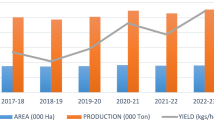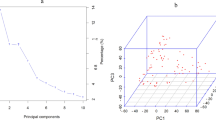Summary
The magnitude of genetic expression and associations among traits are important for the prediction of response to selection in diverse environments and provide the basis for planning and evaluating breeding programs. In this regard, a cross classification mating design was used to produce hybrid sorghum populations, which were evaluated in a randomized completed block design with three replications at four environments in Northern Cameroon. Data on grain yield, days to anthesis, plant height, inflorescence length, threshing percentage and seed mass were collected and subjected to statistical genetic analyses. Significant genotype × environment interaction effects were observed for all traits. Genetic variance was essentially attributed to additive gene effects, with dominance variance for grain yield being negligible. However, the reverse was observed for threshability. Genetic variance components were much higher for plant height and grain yield than for days to anthesis, seed mass and threshability. Heritability estimates for plant height and inflorescence length were high (77 and 54 percent respectively) while the estimates for grain yield and threshability were low (14 and 5 percent respectively). Grain yield had positive genotypic correlation with most of the traits. Days to anthesis were negatively correlated with vegetative and reproductive traits. These results suggest that improvement of days to anthesis, plant height, and inflorescence length should be faster because of higher heritabilities and greater phenotypic variation. However, selection for earliness and reduced plant height would not be possible without hampering grain yield. Selecting for yield primary components namely inflorescence length and seed weight would be effective for increasing production. In addition, optimizing agronomic practices and improved experimental design would increase the selection efficiencies.
Similar content being viewed by others
References
Andrews, D.J., G. Ejeta, M. Gilbert, P. Goswani, K. Anand Kumar, A.B. Mauder, K. Porter, K.N. Rai, J.F. Rajewskei, V.S. Belum Reddy, W. Stegmeier & B.S. Takukdar, 1977. Breeding hybrid parents. In: Proceedings of the International Conference on Genetic Improvement of Sorghum and Pearl Millet. ICRISAT- INTSORMIL. Lubbock Texas, USA, pp. 173–187.
Annicchiarico, P., G. Chiari, Delli, S. Doucene, N. Yallaoui-Yaïci & F. Bellah, 2000. Response of durum wheat cultivars to Algerian environments. IV. Implication on a national breeding strategy. J Agric Environ For Int Develop 96: 227–259.
Axtell, J., I. Kapran, Y. Ibrahim, G. Efeta, & D.J. Andrews, 1999. Heterosis in sorghum and pearl millet. In: Proceedings of the Genetic and Exploitation of Heterosis in Crops. ASA-CSSA-SSSA, WI, USA, pp. 375–386.
Blum, A., 1988. Plant breeding for stress environments. CRC Press, Inc. Boca Raton, FL. p. 43–77.
Burton, G.W., 1974. Recurrent restricted phenotypic selection increases forage yields of Pensacola bechiagrass. Crop Sci 14: 831–835.
Coyne, D.P., 1967. Correlation studies in Saparagus in relation to cumulative seasons yield. Hort Res 7: 105–112.
Diz, D.A. & S.C. Schank, 1995. Heritabilities, genetic parameters, and responses to selection in pearl millet × elephantgrass hexaploid hybrids. Crop Sci 35: 101–103.
Ducan, R.R., P.J. Bramel-Cox & F.R. Miller, 1991. Contributions of introduced sorghum germplasm to hybrid development in the USA. p. 69–101. In: H.L. Shands & L.E. weiser (eds.) Use of Plant Introduction in Cultivars Development – Part 1. CSSCA Spec. Publ. 17. CSSA, Madison, WI.
Falconer, D.S., 1989. Introduction to Quantitative Genetics. 3rd ed. Longman Scientific & technical, Essex. England.
Fischer, R.A., 1981. Optimising the use of water and nitrogen through breeding of crops. Plant and Soil 58: 249–278.
Food and Agriculture Organization of the United Nation, 1997. FAO Year book. Bulletins of Statistics series No. 1(2): 162 Food and Agriculture Organization of the United Nation, Rome.
Hallauer, A.R. & J.B. Miranda, 1988. Quantitative genetics in Maize breeding 2nd ed. Iowa State Univ. Press, Ames, IA.
Houle, D., 1992. Comparing evolvability and variability of quantitative traits. Genetics 130: 195–204.
IBPGR/ICRISAT, 1993. Description for sorghum. IBPGR Secretariat, FAO, Rome, Italy. pp. 1–26.
Ibrahim, O.E., W.E. Nyquist, & J.D. Axtell, 1985. Quantitative inheritance and correlations of agronomic and grain quality traits of sorghum. Crop Sci 24: 649–654.
Johnson, Herbert, W., H.F. Robinson & R.C. Comstock, 1955. Genotypic and Phenotypic correlations in soybeans and their implication in selection. Agron. Jour 47: 477–483.
Lothrop, J.E., R.E. Atkins & O.S. Smith, 1985. Variability for yield and yield components in IAP1R grain sorghum random-mating population I. means, variance components, and heritabilities. Crop Sci 23: 235–240.
Ludlow, M.M. & R.C. Muchow, 1990. A critical evaluation of traits for improving crops yields in water-limited environments. Adv. Agron 43: 107–152.
Nguyen, H.T. & D.A. Sleper, 1983. Theory and Application of half-sib mating in forage grass breeding. Theor Appl Gent 64: 187–196.
Plett, S., L.A. Nelson, & M.D. Clegg, 1991. Selecting for earliness and yield in sorghum at different sites. Can. J. Plant Sci. 71: 191–194.
Poehlman, J.M., 1987. Breeding sorghum and millet. In: Breeding Field Crop. AVI Pub CO., Westport, CI. pp. 508–588.
SAS Institute, 1989. SAS Users' Guide: Statistics. Version 5ed. SAS Institute, Cary, NC.
Vello, N.A. & R. Vencovsky, 1974. Variancias associadas as estimativas de variancias geneticas e coeficientes de herdabilidade. Rel. Cient. Inst.Genet. (ESALQ-USP) 8: 238–248.
Wenzed, W.G., 1994. Partitioning the phenotypic variance of grain yield and its components. Sorghum Newsletter 35: 71–72.
Windmeijer, P.N. & W. Andriesse, 1993. Inland valleys in West Africa: An agro-ecological characterization of rice – growing environments, Publication 52. International Institute for Land Reclamation and Improvement, Wageningen, The Netherlands.
Author information
Authors and Affiliations
Corresponding author
Rights and permissions
About this article
Cite this article
Kenga, R., Tenkouano, A., Gupta, S.C. et al. Genetic and Phenotypic Association between Yield Components in Hybrid Sorghum (Sorghum bicolor (L.) Moench) populations. Euphytica 150, 319–326 (2006). https://doi.org/10.1007/s10681-006-9108-5
Received:
Accepted:
Published:
Issue Date:
DOI: https://doi.org/10.1007/s10681-006-9108-5




